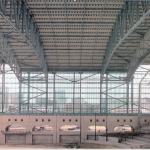How Cellular Beams Are Made
Cellular beams are the contemporary version of the classic, much-loved castellated beam used to create thousands of structures worldwide. Like many innovations over the last few years, they have been modernized to suit the needs of an ever-changing world that seeks to strike a balance between strength and flexibility.
Where castellated beams had hexagonal holes, cellular beams have circular holes. These beams were often made by separating them by half a pitch and then welding them back together. They’re used to achieve an industrial aesthetic in particular places through exposed structural steelwork, shallow down stand floor beams, and even economic floor and roof spans. Here’s what to know about how cellular steel beams are made:
The Materials Used to Make Cellular Beams
Cellular beams are often made of aluminum and other materials like ceramics, plastics, and polymers. The C-sections in cellular beams are usually roll-formed or extruded, and roll forming allows it to handle stronger yet lighter metals that extrusion cannot support. The process of roll forming begins at a slow pace, allowing C-sections to be drop gauged without compromising strength and durability.
An Endless Number of Ways to Form Cellular Beams
Cellular beams benefit from a flexible creation process since you can form an infinite number of cellular beams in 1-millimeter increment depths. The designer can customize the beam depth, cell diameter, and spacing to suit the structure, like steel parking garages.
Thanks to the manufacturing process, cellular beams have an uninterrupted string of cells along the entire beam’s length, making them flexible enough to provide enough service integration cells. As a result, manufacturers can easily supply elongated cells when clients need to pass rectangular-shaped objects through the beam. These beams offer more freedom to accommodate changes, adjustments, and additions for future needs, making it a practical and reliable structural solution.
Using Top and Bottom Tees to Make Cellular Beams
Manufacturers use the top and bottom tees to form cellular beams, often cut from various rolled sections. The result is a tee or a flange that will adequately support the load it carries while suiting its restraint conditions.
This feature makes it particularly advantageous for composite construction, where concrete slab assumes the role of resisting most of the compression found in the composite beam. As a result, it is possible to use a smaller and lighter top tee for the shaft.
The Other Processes Involved
As mentioned earlier, C-sections can be extruded, which efficiently produces lengthy parts. However, the extrusion process cannot create secondary methods like embossing, slots, or notches. Before these operations can happen, the extruded sections must go through another aging process, which occurs in an oven. On the other hand, the roll forming process combines secondary techniques into one progression.
The Cost of Making Cellular Beams
Extrusion is generally more affordable for low-volume C-section projects than roll forming. However, for those pursuing high-volume production, the labor costs and set up of roll forming will bring the total cost down to even below extrusion’s price.
Conclusion
Cellular beams are modern marvels of construction that have enhanced many buildings’ structural integrity, making them essential in many projects. These innovative structural solutions have made it easier for designers, architects, and engineers to realize their vision for a building. By knowing the process of producing cellular beams, you’ll understand what gives it its characteristic strength and flexibility and what sets it apart from other materials.
C-Beams is the proud supplier of high-quality cellular steel beams. We provide fabricated structural welded sections of varying shapes and sizes used in many construction and manufacturing applications, fabricated from steel wide flange beams or plate sections. Contact us today to find out more about what we can do for you!






